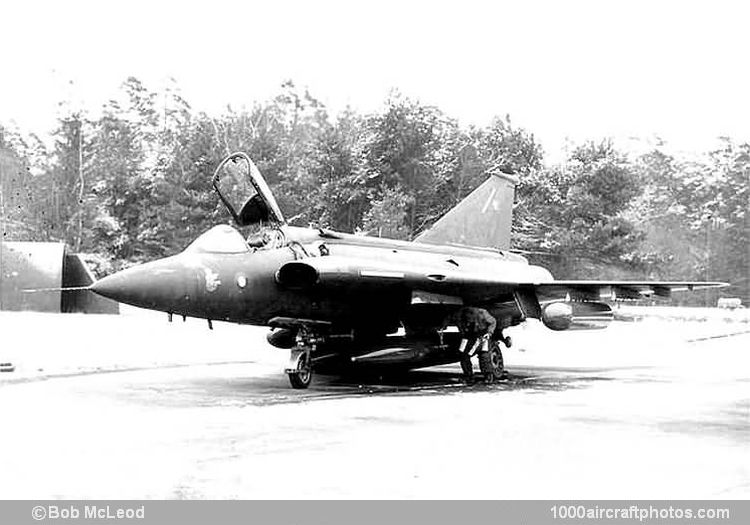03/15/2017. Remarks by Johan Visschedijk: "Three prototypes Saab 35 were ordered in April 1952 and the first made its maiden flight on October 25, 1955, with Chief Test Pilot Bengt R. Olow at the controls. The aircraft was powered by a 9,450 lb (4,290 kg) st Svenska Flygmotor RM5 (license-built Rolls-Royce RA.7R Avon) engine with simple afterburner.
Named Draken (Dragon) the Saab 35 was ordered into quantity in August1956, being designated J 35A (J for Jakt or Fighter) by the Flygvapnet (Royal Swedish AF). These were powered by the RM6B, rated at 15,000 lb (6,804 kg) with afterburning, and armed with a pair of 1.18 in (30 mm) Aden cannon in the wings plus four Rb324 Sidewinder AAMs. Production deliveries started late in 1959 and until 1962 a series of ninety J 35A was completed, including prototypes. From the 66th aircraft a new afterburner was introduced in a new rear fuselage. The aircraft entered service with wing F 13 in March 1960, which found them easy to fly and maintain, and very robust. During 1959-1960, 25 of these aircraft were converted into two-seat Sk 35C trainers.
A refined model, designated J 35B, went into production in late 1961. This was equipped with the Saab S 7 collision-course fire-control system (integrated with the Swedish Stril 60 air defense environment), had a slightly longer fuselage, improved canopy and retractable twin tail wheels (which were retro-fitted to the J 35A). Power plant and armament were the same as the J 35A, many of which were later brought up to J 35B standard.
An increase in engine power, by using the 17,260 lb (7,829 kg) RM6C followed, with the J 35D, which also had increased internal fuel capacity and a Saab FH5 autopilot. First flown on December 27, 1960, the 35D model did not enter production until 1962, with service a year later.
The final production version for the Flygvapnet was the J 35F, which featured an improved version of the S7 fire-control system and provision for both the radar-homing and IR-homing versions of the Falcon AAM, built under license in Sweden as the Rb27 and Rb28 respectively. Production of the J 35F reached 230.
The first attempt to export this outstanding aircraft met with failure. In 1960, a single Saab 35H (Helvetia) fitted with Ferranti Airpass II radar was produced for Swiss evaluation. The project was abandoned after Switzerland opted for the Mirage III.
In 1968, however, the Danish government selected the Saab 35X for the Royal Danish AF. Based on the J 35F, the 35X had a greatly increased attack capability. With a maximum external load of 9,921 lb (4,500 kg) and with two drop-tanks and two 1,000 lb (454 kg) bombs on a high-low-hi profile mission the radius of action was 621 mls (1,000 km). A total of 46 aircraft were delivered from 1970 to 1972, comprising 20 A 35XD (attack and intercept tasks), 20 S 35XD (reconnaissance) and six Sk 35XD (training), designated by the Danish AF as respectively F 35 (equipping 725 Squadron), RF 35 (equipping 729 Squadron) and TF 35 (split between the two squadrons).
The second export customer for the Draken was Finland, ordering 12 Saab 35S in 1970. Prior to their acceptance, the Finns leased six Flygvapnet J 35Bs, now designated J 35BS, which they subsequently purchased. Later a further 29 ex-Flygvapnet Drakens were acquired: 24 J 35FS fighters and five Sk 35CS trainers.
The final export customer for the Draken was Austria, ordering 24 refurbished J 35D, designated Saab 35÷ (÷ for ÷sterreich, German for Austria), deliveries started in 1987.
In 1985, the Swedish AF decided to modify and refurbish approximately sixty J 35Fs into a new version, the J 35J, with more powerful missile armament, longer range and up-dated avionics. These aircraft were to serve in the Swedish Air Force well into the mid-1990s. The last J 35J was withdrawn from service on December 8, 1998, giving a basic service life of over 38 years for this remarkable Swedish fighter of which 607 were produced including prototypes, of these, at least 185 were converted and served under a new designation."
